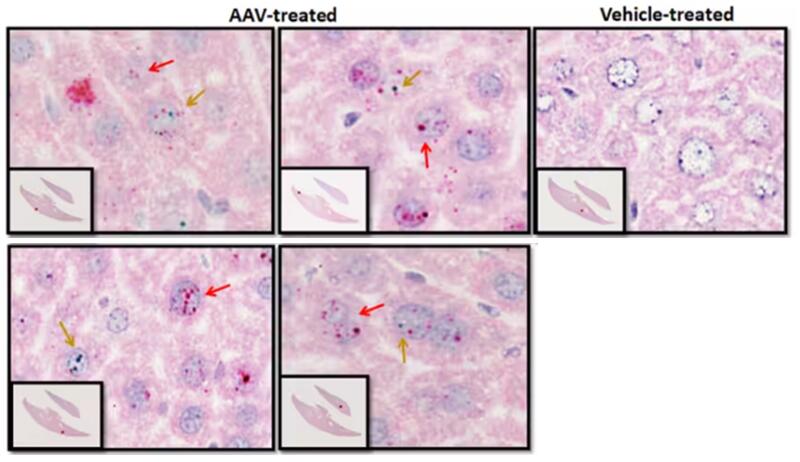CONTACT SUPPORT
Online Inquiry
The AAV Biodistribution (RNA ISH assay) Services from Creative Bioarray provide an unparalleled sensitive and specific method for cell and tissue-specific assessment of gene therapy vector and transgene expression analysis in any tissue.
The RNA ISH method has several advantages and potential applications in AAV biodistribution detection. RNA ISH assay allows for the detection of specific RNA molecules, offering high specificity in identifying the presence of AAV genomes or transgene expression. And this method is highly sensitive and can detect low levels of RNA, enabling the detection of AAV biodistribution even at low vector doses or in tissues with low transduction efficiency. Apart from that, RNA ISH assay can be combined with histological staining methods, such as immunohistochemistry, enabling the correlation of AAV biodistribution with cellular phenotypes or tissue architecture.
 Figure 1. RNA ISH staining allows visualization and quantification of transgene expression (red arrow) and AAV vector (green arrow) presence in treated liver samples.
Figure 1. RNA ISH staining allows visualization and quantification of transgene expression (red arrow) and AAV vector (green arrow) presence in treated liver samples.

Gene therapy development requires a comprehensive understanding of the unique aspects of these products in relation to its in vivo safety profiles. Recombinant adeno-associated virus (AAV) has recently emerged as a highly popular gene delivery vector for a wide range of gene therapy and vaccine applications. As a pioneer company in the field of gene therapy, Creative Bioarray is capable of offering AAV biodistribution analysis service in the most high-quality and cost-effective way. And we focus on the RNA ISH assay that can provide single-cell AAV biodistribution data for every tissue type.
As stated by the USFDA, "The biodistribution data, coupled with other preclinical safety endpoints such as clinical pathology and histopathology, help determine whether vector presence or gene expression correlates with any tissue-specific detrimental effects in animals." (FDA Guidance for Industry: Preclinical Assessment of Investigational Cellular and Gene Therapy Products, November 2013). This is particularly important in germ-line tissues (i.e., gonads) to determine intertied transmission status. Our AAV distribution services can help you accelerate your gene therapy development.
AAV Biodistribution studies are performed to determine the in vivo distribution of a drug product to support early biotherapeutic drug development. Analysis of the persistence of the vector (gene therapy product) to target and non-target tissues following direct in vivo administration in animals can be useful for the identification of potential target organs of toxicity. This assessment is thus an essential part of the overall safety profile of the gene therapy product.
Our customer service representatives are available 24hr a day! We thank you for choosing Creative Bioarray as your preferred AAV Biodistribution Service provider.
References